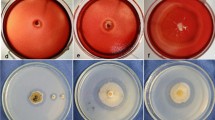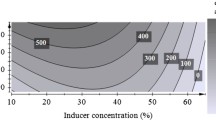Abstract
Xanthomonas axonopodis pv. punicae strain—a potent plant pathogen that causes blight disease in pomegranate—was screened for cellulolytic and xylanolytic enzyme production. This strain produced endo-β-1,4-glucanase, filter paper lyase activity (FPA), β-glucosidase and xylanase activities. Enzyme production was optimized with respect to major nutrient sources like carbon and nitrogen. Carboxy methyl cellulose (CMC) was a better inducer for FPA, CMCase and xylanase production, while starch was found to be best for cellobiase. Soybean meal/yeast extract at 0.5 % were better nitrogen sources for both cellulolytic and xylanolytic enzyme production while cellobiase and xylanase production was higher with peptone. Surfactants had no significant effect on levels of extracellular cellulases and xylanases. A temperature of 28 °C and pH 6–8 were optimum for production of enzyme activities. Growth under optimized conditions resulted in increases in different enzyme activities of around 1.72- to 5-fold. Physico-chemical characterization of enzymes showed that they were active over broad range of pH 4–8 with an optimum at 8. Cellulolytic enzymes showed a temperature optimum at around 55 °C while xylanase had highest activity at 45 °C. Heat treatment of enzyme extract at 75 °C for 1 h showed that xylanase activity was more stable than cellulolytic activities. Xanthomonas enzyme extracts were able to act on biologically pretreated paddy straw to release reducing sugars, and the amount of reducing sugars increased with incubation time. Thus, the enzymes produced by X. axonopodis pv. punicae are more versatile and resilient with respect to their activity at different pH and temperature. These enzymes can be overproduced and find application in different industries including food, pulp and paper and biorefineries for conversion of lignocellulosic biomass.





Similar content being viewed by others
References
Alves-Prado HF, Pavezzi FC, Leite RSR, De Oliveira VM, Sette LD, Dasilva R (2010) Screening and production study of microbial xylanase producers from Brazilian cerrado. Appl Biochem Biotechnol 161:333–346
Bakshi A (1988) Lignocellulytic activity of a soil actinomycete and its mutant. MSc thesis, PanjabUniversity, Chandigarh, India, pp 47–50
Banerjee G, Scott-Craig JS, Walton JD (2010) Improving enzymes for biomass conversion: a basic research perspective. Bioenergy Res 3:82–92
Berlin A, Gilkes N, Kilburn D, Bura R, Markov A, Skomarovsky A, Okunev O, Gusakov A, Maximenko V, Gregg D, Sinitsyn A, Saddler J (2005) Evaluation of novel fungal cellulase preparations for ability to hydrolyze softwood substrates—evidence for the role of accessory enzymes. Enzyme Microb Technol 37(2):175–184
Bernier R, Desrochers M, Jurasek L, Paice MG (1983) Isolation and characterization of a xylanase from Bacillus subtilis. Appl Environ Microbiol 46(2):511–514
Brown L, Torget R (1996) Enzymatic saccharification of lignocellulosic biomass. NREL Laboratory Analytical Procedure LAP #009, National Renewable Energy Laboratory, Golden, CO, pp 1–13
Chapon V, Czjzek M, El Hassouni M, Py B, Juy M, Barras F (2001) Type II protein secretion in gram-negative pathogenic bacteria: the study of the structure/secretion relationships of the cellulase Cel5 (formerly EGZ) from Erwinia chrysanthemi. J Mol Biol 310(5):1055–1066
Gao J, Weng H, Zhu D, Yuan M, Guan F, Xi Y (2008) Production and characterization of cellulolytic enzymes from the thermoacidophilic fungal Aspergillus terreus M11 under solid-state cultivation of corn stover. Bioresour Technol 99(16):7623–7629
Ghose TK (1987) Measurement of cellulase activities. Pure Appl Chem 59:257–268
Ghose TK, Bisaria VS (1987) Measurement of hemicellulase activities. Part 1: xylanases. Pure Appl Chem 59:1739–1752
Gibson DM, King BC, Hayes ML (2011) Bergstrom GC (2011) Plant pathogens as a source of diverse enzymes for lignocellulose digestion. Curr Opin Microbiol 14:264–270
Goering HK, Van Soest PJ (1970) Forage Fibre Analysis ( Apparatus, Reagents, Procedures and Some Applications). Agriculture Handbook No. 379 Agriculture Research Service, USDA, Washington DC
Grigorevski de Lima AL, do Nascimento RP, da-Silva Bon EP, Coelho RR (2005) Streptomyces drozdowiczii cellulase production using agro-industrial by –products and its potential use in the detergent and textile industries. Enzyme Microb Technol 37:272–277
Hulme MA, Stranks DW (1970) Induction and the regulation of production of cellulase by fungi. Nature 226(5244):469–470
Jang HD, Chen KS (2003) Production and characterization of thermostable cellulases from Streptomyces transformant T3-1. World J Microbiol Biotechnol 19:263–268
Jaradat Z, Dawagreh A, Ababneh Q, SaadounI (2008) Influence of culture condition on cellulase production by Streptomyces sp. (Strain J2). Jordan J Biol Sci 1(4):141–146
Juge N, Svensson B (2006) Proteinaceous inhibitors of carbohydrate-active enzymes in cereals: implication in agriculture, cereal processing and nutrition. J Sci Food Agric 86:1573–1586
Kamble RD, Jadhav AR (2012) Isolation, purification, and characterization of xylanase produced by a new species of Bacillus in solid state fermentation. Int J Microbiol 2012:1–8
Kamoun S, Kado CI (1990) A plant-inducible Gene of Xanthomonas campestris pv. campestris encodes an exocellular component required for growth in the host and hypersensitivity on non hosts. J Bacteriol 172(9):5165–5172
Kang MK, Maeng PJ, Rhee YH (1996) Purification and characterization of two xylanases from alkaliphilic Cephalosporium spp. strain RYM-202. Appl Environ Microbiol 62(9):3480–3482
Kazemi-Pour N, Condemine G, Hugouvieux-Cotte-Pattat N (2004) The secretome of the plant pathogenic bacterium Erwinia chrysanthemi. Proteomics 4(10):3177–3186
King BC, Waxman KD, Nenni NV, Walker LP, Bergstrom GC, Gibson DM (2011) Arsenal of plant cell wall degrading enzymes reflects host preference among plant pathogenic fungi. Biotechnol Biofuels 16(4):4
Lynd LR, Laser MS, Bransby D, Dale BE, Davidson B, Hamilton R, Himmel M, Keller M, McMillan JD, Sheehan J, Wyman CE (2008) How biotech can transform biofuels. Nat Biotechnol 26(2):169–172
Maki M, Leung KT, Qin W (2009) The prospects of cellulase-producing bacteria for the bioconversion of lignocellulosic biomass. Int J Biol Sci 5(5):500–516
Masui DC, Zimbardi AL, Souza FH, Guimaraes LH, Furriel RP, Jorge JA (2012) Production of a xylose-stimulated β-glucosidase and a cellulase free thermostable xylanase by the thermophilic fungus Humicola brevis var. thermoidea under solid state fermentation. World J Microbiol Biotechnol 28(8):2689–2701
McMillan JD, Jenning EW, Mohagheghi A, Zuccarello M (2011) Comparative performance of precommercial cellulases hydrolyzing pretreated cornstover. Biotechnol Biofuels 4:29
Miller GL (1959) Use of dinitrosalicylic acid reagent for determination of reducing sugar. Anal Chem 31(3):426–428
Moreira FG, Reis S, Costa MAF, De Souza CGM, Peralta RM (2005) Production of hydrolytic enzymes by the plant pathogenic fungus Myrothecium verrucaria in submerged condition. Braz J Microbiol 36:7–11
Ortega J (1994) Cell wall degrading enzymes produced by phytopathogenic fungus Colletotrichum gleosporioides. Tex J Sci 46(4):329–335
Rautela GS, Cowling EB (1966) Simple cultural test for relative cellulolytic activity of fungi. Appl Environ Microbiol 14(6):892–898
Saritha M (2011) Microbial treatment of lignocellulosic substrate for enhanced enzymatic digestibility. MSc. Thesis, Indian Agricultural Research Institute, New Delhi, India
Singh RP, Verma JP (1975) Cellulase, pectinase and protease of Indian isolates of Xanthomonas malvacearum. Indian Phytopathol 28(3):379–383
Song JM, Wei DZ (2010) Production and characterization of cellulases and xylanases of Cellulomicrobium cellulans grown in pretreated and extracted bagasse and mineral nutrient medium M9. J Biomass Bioenergy 34:1930–1934
Teather RM, Wood PJ (1982) Use of congo red-polysaccharide interactions in enumeration and characterization of cellulolytic bacteria from the bovine rumen. Appl Environ Microbiol 43(4):777–780
Teymouri F, Laureano-Perez L, Alizadeh H, Dale BE (2005) Optimization of ammonia fiber explosion (AFEX) treatment parameters for enzymatic hydrolysis. Bioresour Technol 96(18):2014–2018
Tribak M, Ocampo JA, García-Romera I (2002) Production of xyloglucanolytic enzymes by Trichoderma viridae, Paecilomyces farinosus, Wardomyces inflatus and Pleurotus ostreatus. Mycologia 94(3):404–410
Vlasenko EY, Ding H, Labavitch JM, Shoemaker SP (1997) Enzymatic hydrolysis of pretreated rice straw. Bioresour Technol 59(2):109–119
Wood TM, Bhat KM (1988) Methods for measuring cellulase activities. Methods Enzymol 160:87–112
Yano KJ, Poulos TL (2003) New understanding of thermostable and peizostable enzymes. Curr Opin Biotechnol 14(4):360–365
Yazdi MT, Woodward JR, Radford A (1990) The cellulase complex of Neurospora crassa: activity, stability and release. J Gen Microbiol 136:1313–1319
Acknowledgment
D.A. is thankful to the Post Graduate School, Indian Agricultural Research Institute, New Delhi, India for providing a fellowship towards an MSc programme.
Author information
Authors and Affiliations
Corresponding author
Electronic supplementary material
Below is the link to the electronic supplementary material.
Supplementary Fig. 1
(DOCX 83.1 kb)
Supplementary Fig. 2
(DOCX 124 kb)
Rights and permissions
About this article
Cite this article
Amat, D., Arora, A., Nain, L. et al. Biomass hydrolyzing enzymes from plant pathogen Xanthomonas axonopodis pv. punicae: optimizing production and characterization. Ann Microbiol 64, 267–274 (2014). https://doi.org/10.1007/s13213-013-0659-0
Received:
Accepted:
Published:
Issue Date:
DOI: https://doi.org/10.1007/s13213-013-0659-0




